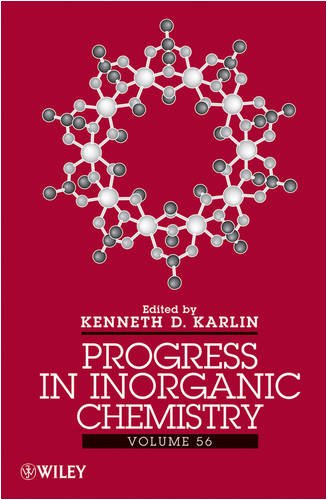

Most ebook files are in PDF format, so you can easily read them using various software such as Foxit Reader or directly on the Google Chrome browser.
Some ebook files are released by publishers in other formats such as .awz, .mobi, .epub, .fb2, etc. You may need to install specific software to read these formats on mobile/PC, such as Calibre.
Please read the tutorial at this link. https://ebooknice.com/page/post?id=faq
We offer FREE conversion to the popular formats you request; however, this may take some time. Therefore, right after payment, please email us, and we will try to provide the service as quickly as possible.
For some exceptional file formats or broken links (if any), please refrain from opening any disputes. Instead, email us first, and we will try to assist within a maximum of 6 hours.
EbookNice Team

Status:
Available4.8
24 reviews
ISBN 10: 0470395478
ISBN 13: 9780470395479
Author: Kenneth D Karlin
This series provides inorganic chemists and materials scientists with a forum for critical, authoritative evaluations of advances in every area of the discipline. Volume 59 continues to report recent advances with a significant, up-to-date selection of contributions by internationally-recognized researchers. The chapters of this volume are devoted to the following topics: • Iron Catalysis in Synthetic Chemistry • A New Paradigm for Photodynamic Therapy Drug Design: Multifunctional, Supramolecular DNA Photomodification Agents Featuring Ru(II)/Os(II) Light Absorbers Coupled to Pt(II) or Rh(III) Bioactive Sites • Selective Binding of Zn2+ Complexes to Non-Canonical Thymine or Uracil in DNA or RNA. • Progress Toward the Electrocatalytic Production of Liquid Fuels from Carbon Dioxide • Monomeric Dinitrosyl Iron Complexes: Synthesis and Reactivity • Interactions of Nitrosoalkanes/arenes, Nitrosamines, Nitrosothiols, and Alkyl Nitrites with Metals • Aminopyridine Iron and Manganese Complexes as Molecular Catalysts for Challenging Oxidative Transformations
Chapter 1: Iron Catalysis in Synthetic Chemistry
I. Introduction
II. Addition Reactions
III. The C–C Bond Formations VIA C–H Functionalization
IV. The C–H Bond Oxidation
V. Cross-Coupling Reactions
VI. Direct C–N Bond Formation VIA C–H Oxidation
VII. Iron-Catalyzed Amination
VIII. Sulfoxidations and Synthesis of Sulfoximines, Sulfimides, and Sulfoximides
IX. Reduction Reactions
X. Trifluoromethylation
XI. Conclusion
Acknowledgments
Abbreviations
References
Chapter 2: A New Paradigm for Photodynamic Therapy Drug Design: Multifunctional, Supramolecular DNA Photomodification Agents Featuring Ru(II)/Os(II) Light Absorbers Coupled to Pt(II) or Rh(III) Bioactive Sites
I. Introduction
II. Photodynamic Therapy
III. Platinum and Rhodium Centers as Bioactive Sites
IV. Supramolecular Complexes as DNA Photomodification Agents
V. Conclusions
Acknowledgments
Abbreviations
References
Chapter 3: Selective Binding of Zn2+ Complexes to Non-Canonical Thymine or Uracil in DNA or RNA
I. Introduction
II. Interaction OF Zn2+ Macrocyclic Complexes with Nucleosides and Single-Stranded Oligonucleotides
III. Interaction of Zn2+ Macrocyclic Complexes with Double-Stranded Nucleic Acids
IV. Recognition of Thymine or Uracil Bulges and Other Non-Canonical Structures
V. Energetic Factors in DNA Binding: Toward More Selective Zn2+ Recognition Agents
VI. Summary
Acknowledgments
Abbreviations
References
Chapter 4: Progress Toward the Electrocatalytic Production of Liquid Fuels from Carbon Dioxide
I. Introduction
II. Electrocatalytic Reduction of CO2
III. Metal Complexes Supported by Macrocycles
IV. Metal Polypyridyl Complexes
V. Metal Phosphine Complexes
VI. Future Development of CO2 Reduction Catalysts: Nature as Inspiration
VII. Summary and Conclusions
Acknowledgments
Abbreviations
References
Chapter 5: Monomeric Dinitrosyl Iron Complexes: Synthesis and Reactivity
I. Introduction
II. Anionic Dinitrosyl Iron Complexes
III. Cationic Dinitrosyl Iron Complexes
IV. Neutral Dinitrosyl Iron Complexes
V. Summary and Perspective
Acknowledgments
Abbreviations
References
Chapter 6: Interactions of Nitrosoalkanes/arenes, Nitrosamines, Nitrosothiols, and Alkyl Nitrites with Metals
I. Introduction
II. Nitrosoalkanes and Nitrosoarenes
III. Nitrosamines
IV. Nitrosothiols
V. Alkyl Nitrites
VI. Outlook
Acknowledgments
Abbreviations
References
Chapter 7: Aminopyridine Iron and Manganese Complexes as Molecular Catalysts for Challenging Oxidative Transformations
I. Aminopyridine Iron Complexes as Molecular Catalysts for Hydrocarbon Oxidations
II. Aminopyridine Manganese Complexes as Molecular Catalysts For Hydrocarbon Oxidations
III. Aminopyridine Iron and Manganese Complexes as Molecular Catalysts for Water Oxidation
IV. Conclusion
Acknowledgments
Abbreviations
References
Subject Index
Cumulative Index
progress in inorganic chemistry
progress in the chemistry of organic natural products
elementary inorganic chemistry
inorganic chemistry review
inorganic chemistry lecture
inorganic chemistry study guide
a work in progress the periodic table khan acaa
Tags: Kenneth D Karlin, Progress, Inorganic